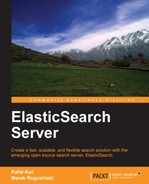The first thing we need to do with ElasticSearch is install it. As with many applications, you start with the installation and configuration, usually forgetting about the importance of those steps until something bad happens. In this chapter we will focus quite extensively on this part of ElasticSearch. Be advised that this chapter is not a definitive guide to every configuration option and parameter. Of course, we would like to describe them all, but if we did that we would have to write a book that is twice (or even more) the size of the one you are holding in your hands! In addition to that, ElasticSearch is like all the other software applications available today—it evolves every day and keeps changing. We will cover only what we feel is commonly required, as well as specific functionalities that are sometimes hard to understand or those that are so wide that having them described in a single place would save you some time. By the end of this chapter, you will have learned the following:
- The basic concepts of ElasticSearch
- How to install and configure your Cluster
- Using the ElasticSearch REST API
- How to create an index
- How to configure your mappings
- How to use dynamic mappings
- What a template is and how to use it
- What routing is and how to use it
- How to use index aliasing
ElasticSearch is an open source search server project started by Shay Banon and published in February 2010. The project grew into a major player in the field of search solutions. Additionally, due to its distributed nature and real-time abilities, many people use it as a document database. Let's go through the basic concepts of ElasticSearch
An index is the place where ElasticSearch stores data. If you come from the relational database world, you can think of an index like a table. But in contrast to a relational database, the table values stored in an index are prepared for fast and efficient full-text searching and in particular, do not have to store the original values. If you know MongoDB, you can think of the ElasticSearch index as being like a collection in MongoDB; and if you are familiar with CouchDB you can think about an index as you would about the CouchDB database.
The main entity stored in ElasticSearch is a document. In an analogy to relational databases, a document is a row of data in a database table. Comparing an ElasticSearch document to a MongoDB one, both can have different structures, but the one in ElasticSearch needs to have the same types for common fields.
Documents consist of fields (row columns), but each field may occur several times and such a field is called multivalued. Each field has a type (text, number, date, and so on). Field types can also be complex—a field can contain other subdocuments or arrays. The field type is important for ElasticSearch—it gives the search engine information about how various operations such as comparison or sorting should be performed. Fortunately, this can be determined automatically. Unlike relational databases, documents don't need to have a fixed structure; every document may have a different set of fields and in addition to that, the fields don't have to be known during application development. Of course, one can force a document structure with the use of schema.
In ElasticSearch, one index can store many objects with different purposes. For example, a blog application can store articles and comments. Document type lets us easily differentiate these objects. It is worth noting that practically every document can have a different structure; but in real operations, dividing it into types significantly helps in data manipulation. Of course, one needs to keep the limitations in mind. One such limitation is that the different document types can't set different types for the same property.
ElasticSearch can work as a standalone, single-search server. Nevertheless, to be able to process large sets of data and to achieve fault tolerance, ElasticSearch can be run on many cooperating servers. Collectively, these servers are called a cluster and each of them is called a node. Large amounts of data can be split across many nodes via index sharding (splitting it into smaller individual parts). Better availability and performance are achieved through the replicas (copies of index parts).
When we have a large number of documents, we can come to a point where a single node is not enough because of the RAM limitations, hard disk capacity, and so on. The other problem is that the desired functionality is so complicated that the server computing power is not sufficient. In such cases, the data can be divided into smaller parts called shards, where each shard is a separate Apache Lucene index. Each shard can be placed on a different server and thus your data can be spread among the clusters. When you query an index that is built from multiple shards, ElasticSearch sends the query to each relevant shard and merges the result in a transparent way so that your application doesn't need to know about shards.
In order to increase query throughput or achieve high availability, shard replicas can be used. The primary shard is used as the place where operations that change the index are directed. A replica is just an exact copy of the primary shard and each shard can have zero or more replicas. When the primary shard is lost (for example, the server holding the shard data is unavailable), a cluster can promote a replica to be the new primary shard.
